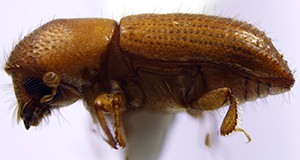
The tea shot-hole borer is an Asian ambrosia beetle introduced to Florida in the early 2000s. In Florida it does not have any known economic impact, but it is a serious pest of tea around the world and is one of the few ambrosia beetles that can infest healthy plants. The tea shot hole borer has a symbiotic relationships with the ambrosia fungus Fusarium ambrosium (Gadd & Loos), which is also a weak plant pathogen. This 4-page fact sheet includes diagnosis section with guidance for avoiding misidentification. Written by You Li, Andrea Lucky, and Jiri Hulcr, and published by the UF Department of Entomology and Nematology, June 2015.
http://edis.ifas.ufl.edu/in1090
Tag: Ambrosia beetles
An ambrosia beetle Xyleborus affinis Eichhoff, 1868 (Insecta: Coleoptera: Curculionidae: Scolytinae)
 Xyleborus affinis is one of the most widespread and common ambrosia beetles in the world. It is also very common in Florida. Like other ambrosia beetles, it bores tunnels into the xylem of weakened, cut or injured trees and farms gardens of symbiotic fungus for food. Females lay eggs in the fungus-lined galleries and larvae feed exclusively on the fungi. Recent studies have shown that Xyleborus affinis can vector the fungus responsible for laurel wilt disease, which is lethal to numerous species of trees in the Lauraceae family. This 5-page fact sheet was written by Lanette Sobel, Andrea Lucky, and Jiri Hulcr, and published by the UF Department of Entomology and Nematology, June 2015. (Photo credit: Juri Hulcr, UF/IFAS)
Xyleborus affinis is one of the most widespread and common ambrosia beetles in the world. It is also very common in Florida. Like other ambrosia beetles, it bores tunnels into the xylem of weakened, cut or injured trees and farms gardens of symbiotic fungus for food. Females lay eggs in the fungus-lined galleries and larvae feed exclusively on the fungi. Recent studies have shown that Xyleborus affinis can vector the fungus responsible for laurel wilt disease, which is lethal to numerous species of trees in the Lauraceae family. This 5-page fact sheet was written by Lanette Sobel, Andrea Lucky, and Jiri Hulcr, and published by the UF Department of Entomology and Nematology, June 2015. (Photo credit: Juri Hulcr, UF/IFAS)
http://edis.ifas.ufl.edu/in1094